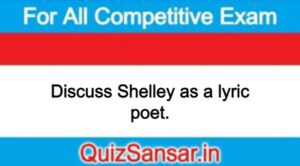
Discuss Shelley as a lyric poet.
Discuss Shelley as a lyric poet.
Or
Give your estimate of Shelley’s lyricism.
Or
Swinburne calls Shelley a ‘supreme singing God’. In the light of this observation discuss Shelley as a lyric poet, giving examples from the poems you have read.
Ans.
Shelley as a True Lyric Poet
Prof. Elton observes: “Shelley’s genius was essentially lyrical. All his poetry is really lyrical, for his lyrical impulse penetrates into even his unlyrical verse.” Shelley’s intensely imaginative and sensitive nature was aptly fitted for the lyric, and into lyrics, both personal and impersonal he poured the best of his poetic genius. His soul came out in his lyrics. His heart flowed out in his lyrics. His very personality melted out in his song, until he ceased to be a man and become a voice, a lyric incarnate. The art of lyricism which flourished in the Elizabethan Age and was nourished by Wordsworth in the 19th century was perfected by P. B. Shelley in the Romantic Age.
A Wide Range and Variety of Lyrics
Shelley’s lyrics are both personal and impersonal, In personal lyrics, Shelley deals with love and life, his sorrows and miseries. In impersonal lyrics, he describes the beauty of Nature and his hope for revolutionary idealism. The poet’s lyrical genius is best expressed in his small and personal lyrics like A Lament, Stanzas Written in Dejection Near Naples, One Word is too Often Profound, Lines to an Indian Air.
The Main Features of Shelley’s Lyrics
A Note of Spontaneity: Shelley’s lyrics seem to come direct from his heart with a wonderful ease and felicity. He gives his lyrics to the world as naturally and spontaneously as flowers exhale their fragrance in the morning. The spontaneity, the splendid abandonment, the musical rush of the lines, these things make us his willing captives. There is spontaneous overflow of powerful feelings in his songs and in the most powerful language. Like his own skylark, he pours fourth his heart in profuse strains of unpremeditated art. There is no laboured artistry and studied deliberation in his lyrics.
Musical Strain: Shelley’s strength lies in his music for more than in his thought. He has both word-music and the music of sound. His skylark is a triumph of musical harmony and the melody of the poem rings in our ears. So is the case with his other lyrics, especially West Wind, Near Naples and Cloud. Shelley has the art of combining the quality of music with the outer rhythm of the verse and the inner rhythm of thought and imagery. Rhythm comes as naturally to him as breathing. His music flows from each like a bud from a rose bush. Like skylark, he goes on singing higher and higher :
“Like a poet hidden
In the light of thought,
Singing hymns unbidden,
Till the world is wrought
To sympathy with hopes and fears it heeded not.”
Pouring Out of Emotions: The ecstatic quality of Shelley’s lyrics is not a permanent feature since the note of melancholy and despair can equally well be sounded by the poet in his lyrics. His lyrics such as A Lament, Ode to the West Wind, One Word Is Too Often Profound, To A Skylark, Stanzas Written in Dejection Near Naples, are effusions of powerful emotions of grief, love, hope and joy. In Stanzas Written in Dejection Near Naples, he expresses the deep agony of his heart. He is dejected for the loss of his health, hope, peace, fame, power and love :
“Alas! I have nor hope nor health
Nor peace within nor calm around.”
In To the West Wind, he describes his miserable condition in the following words:
“Oh, lift me as a wave, a leaf, a cloud!
I fall upon the thorns of life! I bleed!”
Firm Faith in Revolutionary Idealism: Shelley has a firm faith in his revolutionary idealism. He requests the West Wind to drive his dead thoughts over the universe like withered leaves to quicken a new birth and become the trumpet of prophecy :
“If winter comes, can spring be far behind.”
His revolutionary idealism leads to a world which is free from worldly desires. People do not waste time in vain thoughts of past and nature. They are free from evils of hate, pride and fear.
His Style and Language: Shelley’s style is simple, flexible and passionate. It has a direct clarity, an easy yet striking lucidity, and a purity of language which are peculiarly Shelley’s own. His descriptive powers at once strikes the imagination. His images are extremely functional and living. The effect is instantaneous. His favourite device is personification. As regards an example of imagery, his To a Skylark is the most suitable illustration of a very appropriate use of images. The poet compares the skylark with several objects, chief among them are the cloud of fire, a star of Heaven, a poet hidden in the light of thought, a highborn maiden in a palace-tower, a rose etc. His lyrics are remarkable for their mastery of form.
Finally it can be said that Shelley’s place as a lyric poet in English literature is assured and permanent.
- What is meant by Database Management System?
- Discuss the advantages and drawbacks of database.
- What do you mean by database ? Discuss its Characteristics.
- What is Data Mining?
- What are the conditions of communication?
- What do you mean by business communication ?
- organization / Differentiate between classical and modern theory of organization
- What is forecasting






